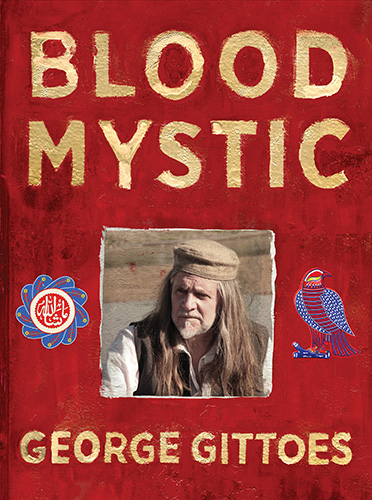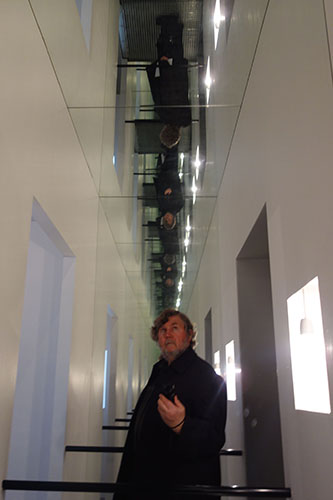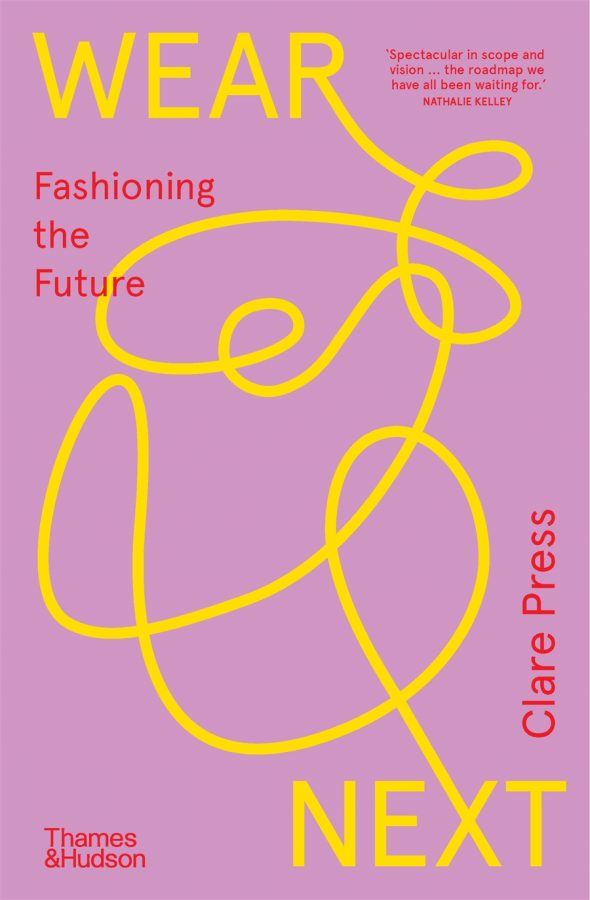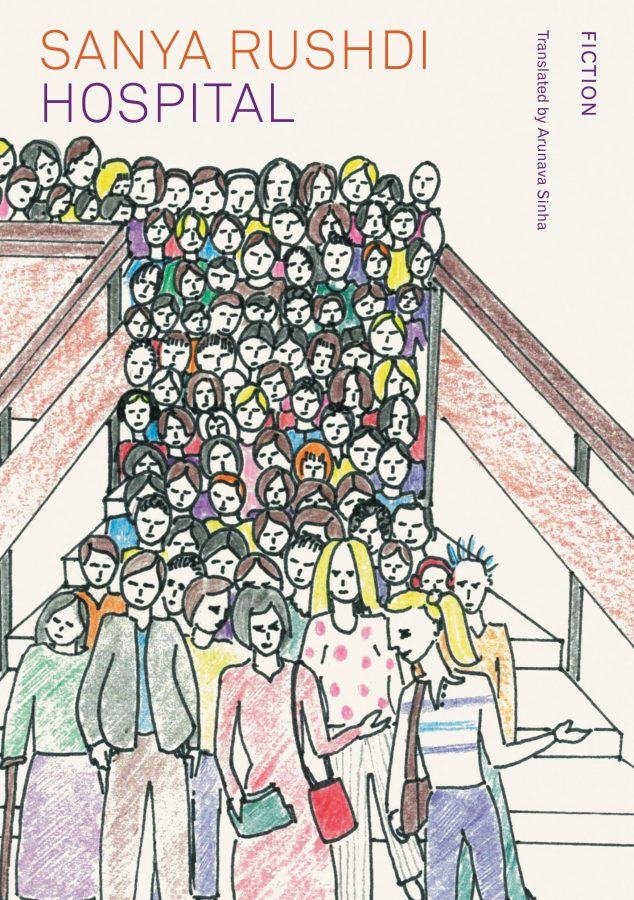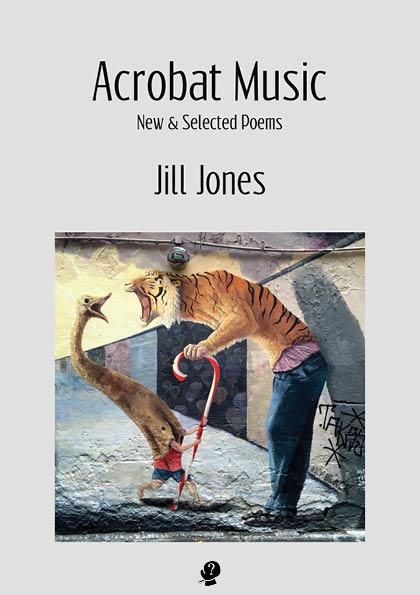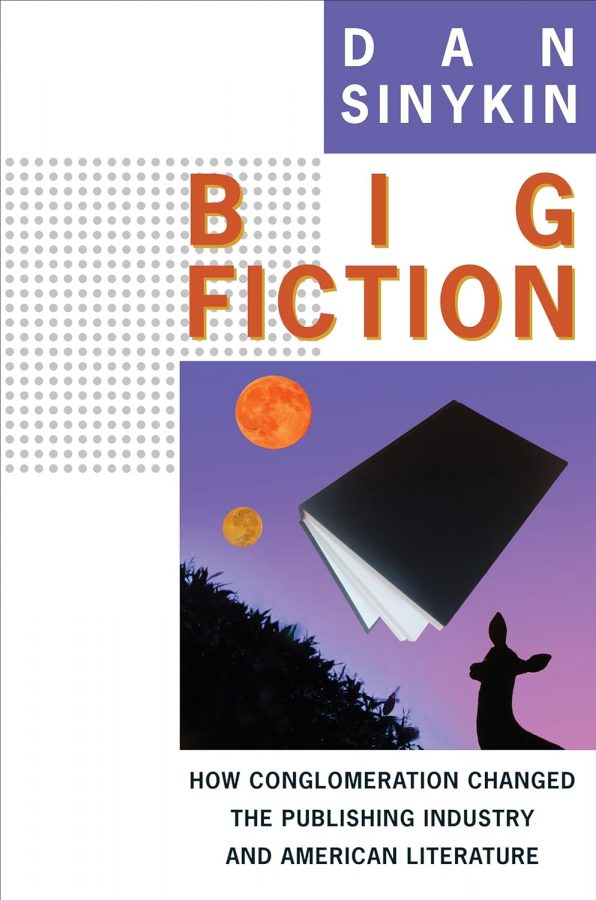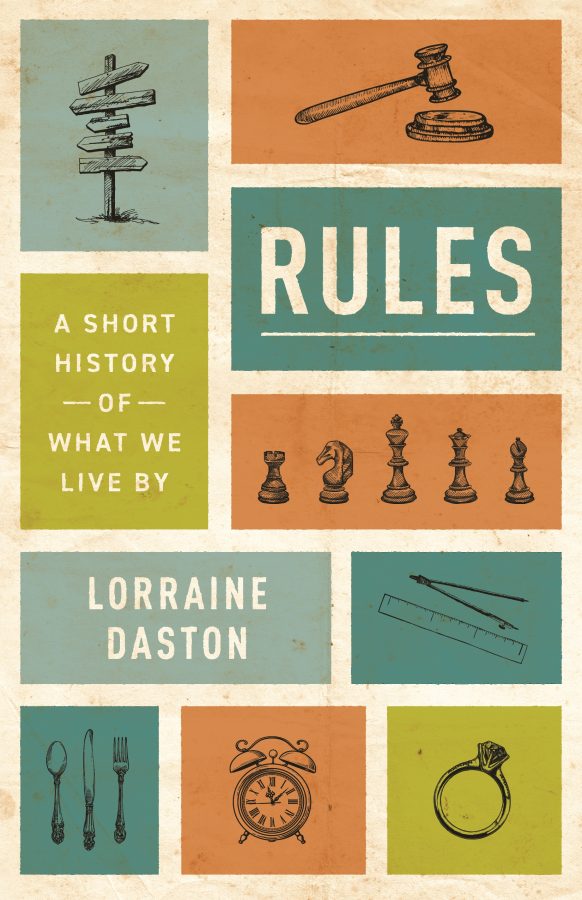Through The Contemporary Darkness: Blood Mystic by George Gittoes
George Gittoes is an autobiographical artist, almost to an obsessional degree, and like his life-long hero, Vincent van Gogh, he is an artist in whom the audience is required to believe, particularly in the sincerity of his autobiographical narrative. Van Gogh’s narrative was created through his letters to his brother Theo that constantly, and in great detail, not only provide a descriptive context for most of his paintings, but also allow us to peer into the soul and emotional state of the artist on the occasions when he created his paintings. Gittoes’ autobiography Blood Mystic is designed to produce a biographical narrative through which to approach and interpret a multimedia opus that includes documentary film, photography, painting, and graphics, plus occasional excursions into puppetry and street theatre. Again, there is the implicit plea for us to believe in the absolute dedication and sincerity of the artist’s mission; after all, as is constantly repeated throughout the 400 pages of the book, the artist has faced death on numerous occasions in the process of making his art.
Gittoes argues essentially for what could be described as duality in his life and art – two very different sides to his life, upbringing and ongoing art practice. By his account, this goes back to his earliest childhood experiences and his grandparents. His maternal grandfather, George Halpin, was an Irish Protestant, whom Gittoes describes as a professional gambler and, basically, a thug and gangster. His grandmother, Lavinia Figtree, was a classically trained musician and painter who eloped with Halpin and together they had five daughters, but no sons. Gittoes’ mother Joyce, who was a ceramicist, bore the only grandson from all of the daughters and Halpin was determined to bring Gittoes up tough, like an Irish street fighter, while Gittoes’ natural inclination was to be an artist. Writing about his childhood in Rockdale in southern Sydney, Gittoes notes:
Growing up between these two houses – one bohemian and creative, the other callous and lethal – made me a contradiction: a sensitive artist aesthete and a street-smart gangster who can face the worst horrors of war and come out undamaged.
This duality is brought out in the title of the book, Blood Mystic. Gittoes relates an anecdote that in 1994 he visited the Orthodox monastery of Saint Catherine on Mount Sinai and a local monk, after examining some of his drawings, told him that he was a ‘blood mystic’. As far as I am aware, this concept is not known in Orthodox theology, but it is an apt descriptor for Gittoes’ practice. While we are generally familiar with his preoccupation with bloody conflicts, his involvement with mysticism has not been widely discussed. Throughout the book, Gittoes constantly cites examples of feeling ‘protected’, where he possessed an inner voice that forewarned him of dangerous situations, when he practiced his magical rites and experienced mystical visions. He speaks of mysticism in its various manifestations throughout the text and notes that he has been interested in mysticism and mystical texts of the Sufis and Rumi since childhood. More interestingly, he speaks of seeing auras, for example, on first meeting Martin Sharp, Gittoes observes ‘Martin’s aura is the deepest blue’, while in another instance describing a certain Abdul Qadir, to Gittoes he appeared to be ‘emitting a light (to me it was yellow)’.
In a recent letter that Gittoes circulated to his friends and media, he explains his childhood experience with auras:
When I was a kid the lights would be turned out in my bedroom at night but there was no darkness. The space surrounding me would fill with the equivalent of millions of butterfly wings, exotic flowers like those in Islamic depictions of Paradise and moving shapes like tropical fish in luminous colours … In daylight I could stare at a mirror and my own features would transform, firstly into something distorted and dark like a Francis Bacon portrait and then become a doorway through the mirror into another reality. As early as primary school I would flick a lens-switch in my eyes and watch the auras of my fellow students float out above their desks and shimmer around their material forms. I asked my sister Pam if she could see the same things and was surprised to find she couldn’t. I had thought my ability was the norm but Pam confirmed, I was very different.”
As an adolescent, when he encountered the work of Wassily Kandinsky, rather than seeing his paintings as a path to abstraction in the formalist sense, Gittoes felt that the Russian artist
was attempting to paint the mystical spiritual world I had seen since childhood and it had nothing to do with formal abstraction, in any way. It was as representational to me as a painting of trees in a park with clouds above in the sky and a pond in the foreground. I decided my mission as an artist should be to show ‘the other side’ of reality enabling people like my sister to see what I see.
While perhaps not embracing a coherent theory of theosophy, the self-declared atheist Gittoes shares many of the premises of the theosophists.
Armed with this inbuilt ‘mystical radar’, Gittoes set out to explore the world. The book is about this journey of exploration that has lasted almost half a century. It is an unconventional autobiography, abandoning linear chronology and employing the cinematic technique of montaging various scenes and written sources. There is a regular narrative, most of which is taken up with experiences at the Yellow House in Jalalabad in Afghanistan, a sort of creative arts centre that Gittoes founded in 2011 and has built up with his partner Hellen Rose. Here we are introduced to a cast of lovable characters, including colourful gangsters, a menagerie of animals, youthful actors and Sufi elders, and Gittoes involves us with the narrative of their lives and especially their experiments with filmmaking. This is interspersed with accounts of episodes from warzones in Africa, the Middle East, the Philippines, Pakistan and South East Asia, as well as accounts of prolonged residencies in Europe and America. Gittoes’ journals, diaries, and extracts from a diary kept by Rose, are added to the mix, as well as a rich sprinkling of drawings, reproductions of paintings, film stills and photographs.
The structure is slightly disorientating, for at one moment we are in Sydney, then jump forty years to Jalalabad, suddenly find ourselves in the killing fields of Cambodia, witness killings in the Philippines and then embrace the rap scene in America accompanied with its violent gangland murders. On a number of occasions, we are thrust into the Rwandan massacre and are exposed to the genocide in graphic detail through a mix of emotive description, documentary photographs, paintings and drawings. A brief chronology at the beginning of the book may provide some orientation, but generally the reader is invited to go with the flow of the narrative and view it as an overall experience. Inherent in this structure is the idea that Gittoes had decided what he was doing with his art and life very early in life, and it is only the locations and the circumstances that change. In some mysterious way, his path seems to have been fixed and it was only the details that were going to be altered.
Central to Gittoes’ philosophy of art making, regardless of its medium, is that every painting, drawing, film or photograph has its story, a ‘piece of journalism’ or actuality footage that takes you to the starting point. For the overwhelming majority of his oeuvre, his art is political in intent, global in reach, and seeks to engage a very broad audience. He once described himself as being on a Beagle-like journey of observation and exploration through the contemporary darkness, collecting samples and specimens along the way. He thinks of his art as the shield of Perseus that can reflect evil on itself as a strategy through which to destroy evil. Throughout the book, he describes the stories behind his films, photographs or drawings and how these are metamorphosed into paintings or whole series of multimedia works. Art in his hands is seen as a weapon that can document what is happening and hopefully prevent it from happening again in the future.
At the outset of the book, Gittoes observes that over ‘the past thirty years my mission has been to place myself at the crossroads of history when war is inevitable and be there when it happens. I do this by conscious choice.’ By being there as an eyewitness, he documents what happens and becomes something of a chronicler of the conflicts of our time. He has probably been to more warzones than most contemporary war correspondents or photojournalists.
The book also provides us with an insight into the psychology of ‘being there’ and experiencing all the danger and horror. He claims that the toughening up process by his uncle George, ‘the most influential force in my young life’, who died when he was seventeen, made him resilient to violence and, by nature, he was immune to fear, but nevertheless with great empathy for the sufferings of others. However, the experience of war with its adrenaline rush, became like a drug of dependence. He writes,
Everyone who has been at the frontline of war knows that, when they are walking into the zone, the change of reality is instant. It’s as real as walking through the doors from the street into an office building. Inside that zone there’s a heightened state of consciousness. This is one of the factors that makes a photojournalist keep going back to war. There’s no buzz like it.
The autobiography, apart from being non-linear in chronology, is also in no way comprehensive, with whole episodes in his life and art omitted. There is an emphasis on Afghanistan and the war work, especially the films, starting with Bullets of the poets (1986) in Nicaragua dealing with the Sandinista women poets and revolutionaries, Soundtrack to war (2003-04) in Iraq, and right through to Love city (2012-13) and Snow monkey (2015) in Jalalabad. His Heavy industry (1990-92) series of paintings and graphics, as well as the early The Hotel Kennedy Suite and The Kent State Suite (1970) series, do not rate a mention, nor does his Berlin period of 2009. The culmination of the book is his being awarded the Sydney Peace Prize in 2015.
The persona that Gittoes conveys in this autobiography is that of a possessed artist who has been somehow chosen for his mission in life and who, against all odds, survives countless perilous situations and manages to prevail over evil. Gittoes also emerges as a celebrity magnet who, on his first trip to America, when he was still in his teens, met Andy Warhol, Joe Delaney (an African-American artist) and the Black Panthers. On returning to Australia, he met Martin Sharp, and Gittoes and his mother Joyce became involved in the Yellow House in Sydney. He then proceeded to make friends with Nelson Mandela and painted the portraits of the Dalai Lama in Sydney and Julian Assange at the Ecuadorian embassy in London. Gittoes is fearlessly opinionated, disparaging of the art world (while craving its recognition) and generally acts and writes like a man living on borrowed time.
Although Gittoes dismisses the idea of post-traumatic stress disorder as something that affects only weak people and not the strong like himself, it seems a miracle that he has maintained a degree of mental and emotional equilibrium after witnessing the horrors to which he has borne testimony. His descriptions of his experiences in Rwanda particularly stick in my memory. He writes: ‘I know I only have a few hours for sleep – but sleeping is impossible tonight. I have seen thousands of people hacked, shot, blown up – the faces will haunt me forever …’ He continues:
This morning I wandered among the dead – after three days of slaughter the refugee camp had been flattened. This place is hell. People caught between the Rwandan RPA soldiers and the Interhamwe machetes – their corpses covered in mud by the battering rain, partially hidden in the shroud of discarded possessions.
Bearing witness to this kind of horror and tragedy must in some way scar a human being. Throughout the book, there are numerous accounts of people dying in his arms, of the artist standing and surveying a field of body parts, graphic records of horribly mutilated bodies and descriptions of the aftermath of bombing raids and terror incidents. If, for a reader, much of this book appears as stomach-turning (and it should not be attempted by the faint-hearted), can it leave the author unscathed? This is the artist’s boast and, having known him for over thirty years, I am in no position to contradict it.
What comes with the territory of an independent war artist (although he has for his various ventures attracted modest amounts of public funding), is strong views on the various international players. America and its military and spy agencies carry the brunt of much of Gittoes’ criticism. On one occasion, he writes, ‘history has so many examples of elites ignoring the suffering of the masses … But are America’s actions in Afghanistan an experiment, a strategic move to exploit its vast mineral wealth, or just folly, like in Iraq?’ In Afghanistan, he has adopted a complex political stance where the local Taliban, the fiercest enemies of the Americans and the target of numerous drone strikes, are his friends and protectors; some of the local gangsters are his collaborators, while Daesh (so-called Islamic State) fighters are his adversaries. Julian Assange, on the other hand, is one of his present-day heroes and he notes in reference to his portrait of Assange, ‘To me, Julian is a modern-day Ned Kelly and I titled the portrait As Game As’.
Gittoes emerges from the book as a remarkably complex character, one who is riddled with conflict, contradictions and at times boastful outbursts. He is a strong, accomplished and passionate draughtsman, who works hard on imagery designed to shock, containing what the German Expressionist artists describe as ‘a heavy dose of ugliness’. He creates uncomfortable pictures that he is quick to relate to specific episodes that he has witnessed and, as a basic article of faith, holds it to be the artist’s duty to be authentic to the initial experience of the narrative. Frequently, he provides photographs and sketches as if to prove that he has invented little in the reality that he has depicted. In the final analysis, Gittoes is a storyteller who feels strongly about his narrative, strongly enough that he is prepared to die for it. The underpinning philosophy is that of an old-fashioned humanist who believes in the sanctity of human life and in the spiritual aspect of being. This human existence is found within a mystical dimension whose natural enemies are technology, economic rationalism and some aspects of applied science. In his films and paintings, despite their grisly realism, often there is a touch of fantasy, a mystical otherness and a hint of sensuousness.
Gittoes from an early age has adopted a global perspective with Australia more of a base than a home. He reflects on the question of belonging in the concluding pages of his book.
I have built this Yellow House [in Jalalabad] over four years and made it a home. Its reality has gradually solidified. The locals know me, the streets and shops of the bazaar are all familiar, as are their owners. I now feel more connected to the world here than at ‘home’, particularly when out walking the streets. People here are always doing things, hand-cutting a field of cauliflower or hammering a piece of twisted metal into something useful, and I can buy that cauliflower, or help hold the metal straight on the bench. I feel an urge to hold onto all of this a bit longer, even if part of me yearns for the comforts of home … My life of constant transit merges reality and dream …
The great Japanese poet and philosopher Matsuo Bashō once wrote about the ordeals of a creative soul: ‘now when autumn is half over, and every morning and each evening brings changes to the scene, I wonder if that is not what is meant by dwelling in unreality’. George Gittoes at 67 has achieved more than many would have thought possible. In the final pages of his autobiography places a question mark concerning his future. His Blood Mystic may mark a certain watershed in his thinking as an artist and possibly in his life. In 2016 he acquired a property at Werri Beach on the NSW South Coast, where he has established a studio. He has also spoken of painting ‘a glimpse of the mystical world on canvas’ like a personal dreamtime. In his 2017 New Year Resolution emailed from Werri he writes,
I have decided it is political for me to do non-political work which asserts the importance of mystical experience … It was making the mystical journey of self-discovery when I was young that gave me the strength to face the horrors of Rwanda and Bosnia. And I know that many of the abilities I developed – particularly that of reading signs – has helped to keep me safe … Of course, I will not stop doing my political films and paintings, but on a personal level I am refusing to hide or suppress this integral aspect.
George Gittoes may be signalling that he is not abandoning his stance as an artist that has developed over the past few decades but, in the future, there may be a bit less blood and a bit more mysticism.
